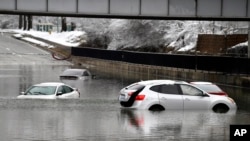Harsh cold descended on the nation's midsection Monday as a polar vortex gripped the Rockies and Northern Plains on the heels of weekend storms that pummeled the Eastern U.S. with floods, killing at least 14 people.
The National Weather Service warned of “life-threatening cold” as wind chills dropped to minus 51 Celsius in parts of North Dakota on Monday and minus 46 C in parts of Montana. Tuesday morning was forecast to be even colder.
Extreme cold warnings were issued for an 11-state swath of the U.S. stretching from the Canadian border to Oklahoma and central Texas, where the Arctic front was expected to bring near-record cold temperatures and wind chills in the single digits by midweek.
Meteorologists had predicted that parts of the U.S. would experience the 10th and coldest polar vortex event this season. Weather forces in the Arctic are pushing chilly air that usually stays near the North Pole into the U.S. and Europe.
Kentucky, Appalachia battered by flooding with at least 13 dead
The death toll in flood-battered Kentucky rose to 12, Gov. Andy Beshear said Monday night. Two fatal vehicle crashes were connected to the severe weather, he said, and at least 1,000 people stranded by floods had to be rescued.
Parts of Kentucky and Tennessee received up to 15 centimeters of rain as severe storms swept across the South. Water submerged cars and buildings in Kentucky and mudslides blocked roads in Virginia.
In West Virginia, where there was one confirmed fatality with several people still missing, Gov. Patrick Morrisey asked President Donald Trump to issue a disaster declaration for a 13-county region ravaged by flooding.
Near Logan, West Virginia, authorities responded Monday night to the spill of acidic water from an abandoned coal mine. The mine blowout damaged a road, making it impassable, fire officials said.
In Atlanta, a person was killed when a large tree fell on a home early Sunday.
Flood warnings were extended Monday across most of Kentucky and portions of Arkansas, Tennessee, Mississippi, Alabama, West Virginia, Virginia and Ohio.
Extreme cold gives the U.S. a taste of the Arctic
This is the coldest month of the year for many locations, and air temperatures may approach record lows in some areas, said National Weather Service meteorologist Jason Anglin in Bismarck.
People should cover exposed skin and limit time outside to avoid frostbite, which can happen in minutes in such low temperatures, Anglin said. Neighbors should check on each other and those who are vulnerable and monitor heater vents to make sure they don't ice up.
Due to the frigid conditions and a “lack of adequate heating fuel,” North Dakota Gov. Kelly Armstrong on Monday waived hours-of-service requirements for commercial-vehicle drivers hauling propane and petroleum products. The waiver is for 30 days.
The cold snap in North Dakota was expected to reduce oil production by about 5%, or about 50,000 to 80,000 barrels a day — pretty typical for such conditions, North Dakota Pipeline Authority Director Justin Kringstad said. It takes about a week once temperatures warm up for volumes to rebound, he said.
Death can happen in minutes for animals in such cold, said Julie Schirado, a founder of the Bismarck-based Furry Friends Rockin' Rescue animal shelter. The shelter works with other rescues, and uses floor kennels, heated garages and basements to house animals, she said.
“We see death a lot but when the cold temperatures hit, then it's jumped up some more. We lose kittens, puppies that are out in this weather ... Frostbite can be wicked,” Schirado said. People should bring their pets indoors in extreme cold.
At the Dakota Zoo in Bismarck, which closed last weekend due to cold, critters such as bison, elk and bighorn sheep don't mind the temperatures as they munch food to stay warm and have shelters to enter, Director Terry Lincoln said. And staff are still out, breaking through ice for their water, he said.
Lincoln, who lives at the zoo, said he walked to his office on Monday morning “and I had an ice-cream headache halfway there. You know it's cold when you have an ice cream headache without eating ice cream.”








